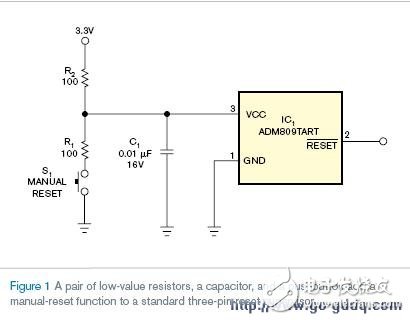Simply add a pair of resistors, a capacitor, and a button switch to convert the standard three-terminal reset manager to manual reset.
Adding a manual reset function usually requires a new circuit to manually reset the input. But by adding a pair of low value resistors, the standard three-terminal reset manager can be used universally. The circuit is shown in Figure 1, ensuring a clean signal from the moment the manual reset button is pressed. When the reset button is triggered, the VCC voltage drops to the reset manager minimum reset limit (the VCC voltage is the voltage divider of R1/R2 when S1 is pressed). This action causes the reset manager output to be valid. When S1 is released, the VCC voltage is restored above the maximum reset limit, which is valid until the reset manager completes the TIme-out period.

When S1 is not pressed, the reset manager supply current and output load will cause the R2 voltage drop. For most reset managers, the maximum supply current is 50 &mICro; A. For most designs, the output goes through one or two CMOS inputs, each requiring 10 μA. With two CMOS devices connected, the total current through R2 will be (2 & TImes; 10 μA) + 50 μA = 70 μA. The voltage drop across R2 is the reset manager reset limit voltage plus 70 μA & TImes; 100Ω = 7 mV.
Consider alternatives to choose the values ​​of R1, R2 and C1. The value of bypass capacitor C1 should be low enough
To allow the reset manager to detect a drop in the instantaneous voltage. The values ​​of R2 and C1 determine the time constant, such as a time constant of 100 Ω & TImes; 0.01 μF = 1 μsec. This formula is obviously higher than the attenuation rate of the adjustable power supply.
When S1 is triggered, current flows through R1 and R2. In the circuit of Figure 1, the current at S1 trigger is 3.3V / (100Ω + 100Ω) = 16.5 mA. The current size satisfies the linear power system, but is not suitable for battery powered systems. Reduce the current by increasing the value of R1 to ensure that the reset manager VCC is below the minimum reset limit. It is also possible to increase R2, but this will result in an increase in voltage drop and a slowdown in transient response. It is important to note that increasing the manual reset current occurs only when a manual reset is active, and a typical system current drop occurs when it is active.
With the original English text
Add a manual reset to a standard three-pin-reset supervisor
Simply adding a couple of resistors, a capacitor, and a pushbutton switch transforms a standard three-pin-reset supervisor into a manual reset.
Derek Vanditmars, Delta Controls, Surrey, BC, Canada; Edited by Charles H Small and Brad Thompson -- EDN, 4/12/2007
Adding a manual reset to a design usually involving designing in a new part with a manual-reset input. But, by adding a couple of low-value resistors, a standard three-pin-reset supervisor can work in most applications. The circuit in Figure 1 ensures a clean signal during and after you have pressed the manual-reset button. When you activate the manual-reset button, the supply voltage drops below the reset supervisor's minimum reset threshold because of the R1/R2 voltage divider formed when S1 is The action causes the reset supervisor to activate its output. When you release S1, the supply voltage returns to above the reset-supervisor maximum-reset threshold, and remains active for the time-out period of the reset supervisor.
When you do not press S1, R2 has a voltage drop arising from the reset supervisor's supply current and output loading. For most reset supervisors, the maximum supply current is 50 μA. For most designs, the output goes to one or more CMOS inputs that With two CMOS devices connected to , the total current through R2 would be (2 × 10 μA) + 50 μA = 70 μA. The voltage drop across R2 due to the current flow beneficial adds 70 μA × 100 Ω = 7 mV to the reset supervisor's reset-threshold voltage.
You should consider several trade-offs for the
The value of R1, R2, and C1. The value of the local bypass capacitor, C1, for the reset supervisor should be under enough to allow the reset supervisor to detect transient supply-voltage drops. The time constant of R2 and C1 determines In this example, the time constant is 100Ω×0.01 μF=1 μsec. This figure is typically much higher than the decay rate of a regulated power supply that has lost power.
When you activate S1, current flows through R1 and R2. In the circuit in Figure 1, the current flow when you activate S1 is 3.3V/(100Ω+100Ω)=16.5 mA. This amount of current would be OK for a line- You can reduce the current by increasing the value of R1 and ensuring that the reset supervisor's supply voltage drops below the minimum reset threshold. You can also increase the value of R2, along With that of R1, but doing so will cause increased voltage drop and slower response to transients. Note that the increased current of the manual reset occurs only while the manual reset is active, and typical system current drops while is active.
This is a special TOVAPO TP018-1800 electronic cigarette product series. We sell Tovapo TP018-1800 vape pen disposable,TP018-1800 vape pen kit,
TP018-1800 vape starter kit,TP018-1800 e-cigarette,950mah vape kit, and other Tovapo vapes.
We are specialized electronic cigarette manufacturers from China, Vapes For Smoking, Vape Pen Kits suppliers/factory, wholesale high-quality
products of Modern E-Cigarette R & D and manufacturing, we have the perfect after-sales service and technical support. Look forward to
your cooperation!
TP018-1800 vape pen disposable,TP018-1800 vape pen kit,TP018-1800 vape starter kit,TP018-1800 e-cigarette,950mah vape kit
Ningbo Autrends International Trade Co.,Ltd. , https://www.vapee-cigarettes.com
